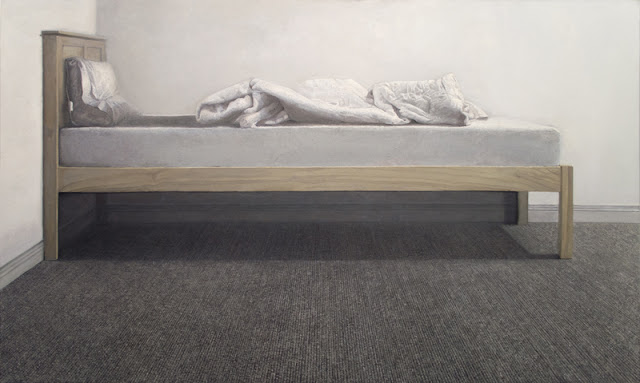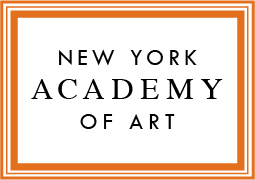“I chose to paint a bed because of its inherent content,” says Stephen Vollo, of his painting of a rather ordinary looking bed. “It’s a place where people have sex, dream, and possibly die. But it’s also a part of our everyday routine. So it has many, often contradictory associations. I wanted to make a painting that allowed this content to come forth, rather than construct a specific narrative around this potent, universal symbol.”
 |
| Bed |
If you find yourself in Copenhagen between now and Halloween, you can see the bed painting up close at Gallery Poulsen, where Stephen’s work hangs alongside paintings by Shangkai Kevin Yu and Abigail Schmidt, as part of the New York Academy of Art Graduates show. If, like most of us, you’re not in Denmark, don’t worry – you can see more of Vollo’s sparsely composed paintings on the Lower East Side, at Mark Miller Gallery, for the 2015 Fellows Show. The show also features the works of Alonsa Guevara Aliaga and Shangkai Kevin Yu, and marks the beginning of these three artists’ exciting careers. The show runs until September 30th.
Below, Stephen discusses his work.
| DogWhat major themes do you pursue in your work? |
What major themes do you pursue in your work?
The subject matter is mundane. I paint the objects, spaces, people and materials that I am most familiar with. The themes vary from painting to painting and are meant to be open ended.
The subject matter is mundane. I paint the objects, spaces, people and materials that I am most familiar with. The themes vary from painting to painting and are meant to be open ended.
Where did you grow up?
I grew up upstate in the town of Webster. It’s a suburb of Rochester.
What inspires you?
Mostly, it’s reflecting on my own experiences in a broader context. Other artists inspire me as well. Not only visual artists, but musicians and writers whose work I admire.
Name three of your favourite painters.
Tell us about your practice – how do you start? With an image, an idea, a story?
It depends. There is not a set order, but I might start by thinking very loosely about a subject. This eventually becomes sketches and even sometimes writing. Then I’ll take photographs or use 3D modelling if I need to. I’ll use any references that can help. But I do a lot of the work by looking at the painting, and not much else.
Talk about your process – how do you apply paint?
Talk about your process – how do you apply paint?
I try to apply paint so it has a physicality. That doesn’t always mean thick. I like the look of semi-opaque to opaque paint. If I glaze, I usually rub in a transparent pigment with little to no medium.
What materials do you like to use and how do you know when your work is finished?
I use oil paints, sometimes with a little bit of alkyd medium. I paint on canvas stretched over panel, so the thick paint has less of a chance of cracking off. Ideally, I know a painting is finished because it seems like it will continue to be interesting once I walk away. Longevity for me has a lot to do with a feeling that the painting continually opens up new meanings, rather than a feeling of closing down. Paintings should also feel relevant and meaningful to my own life. If they don’t, it can be arbitrary. Sometimes I might have a deadline, and be exhausted from trying to make a painting work. In this case, hopefully nothing in the painting embarrasses me too much, and I just let it go. Reluctantly.
If you could retake any class at the Academy what would it be and why?
I don’t think I could retake any. Twenty years of school is more than enough.
How did your work change over the course of your time at the Academy – especially during your post-graduate year?
When I first came to New York, I was using humor, irony, and contradiction within images. Although I don’t think those things have left my work entirely, at a certain point I really stripped things down. I tried to see what kind of narrative was possible if I let the painting be just the viewer’s presence in dialogue with the subject’s presence. I began to find the dynamic of the mobile viewer and the immobile fiction of the painting really compelling. The Fellowship year was tough, because I stripped things back even further, and tried to see how far I could push aspects of the paintings technically. I found some limits for myself.
 |
| Amanda |
What’s the best piece of advice you’ve been given as an artist?
I don’t know if it’s the best, but I remember it. “This looks like you know to draw, but you don’t know how to do anything else.”
What piece of advice would you give incoming Academy students?
You’re paying a lot of money to improve your work, not to prove how good you are.
Name two quirky things we can find in your studio.
Carpet samples. I used to have a studio rabbit that loved classical music and would lie on his back by my feet as I painted.
Tell us about your NYAA thesis paper.
I wrote about the role of touch in the experience of a painting. In art history and art theory it’s referred to as haptics.
What are you reading these days?
I just finished Art and Illusion by Gombrich, and David to Delacroix by Walter Friedlander. Right now, I’m reading a couple of art history books and a collection of essays called Iraq and the Lessons of Vietnam.
Do you paint to music, or in silence? If music (or other audio), what?
I sometimes listen to music. Audio books and lectures are great, too. Silence is probably what I’d prefer most, but it’s not always possible for one reason or another. It’s necessary for parts of the process, though.
 |
| Saint Acisclus |
Discuss one of your own pieces.
The bed started off as a comical, absurd painting. When I took the obvious humor out, I saw something very subtle, that was more interesting. I must have repainted every part of that painting a dozen times, some more.
Discuss a piece by another artist.
I love polychrome sculptures. There’s one at the Hispanic Society of a Saint Acisclus, a martyr with his throat slit – it’s so strange and present. I especially like walking around it, getting a look at the back of his head from the hallway, and then moving around to see his face. I circle around it almost like a minimalist sculpture.
If you weren’t an artist, what would you be?
If I didn’t paint, I’d probably want to work in some other art form. Sometimes I’m curious how my paintings would translate into short stories, poems or novels.
Do you have a favorite paint color?
I don’t have a favorite, but I do like subtle temperature shifts and muted color combinations.
Finally, what are your plans for this year?
I have a job working for an artist in Dumbo. I’ll do that for money, and at night and my days off I’ll continue to work on my paintings. I have some compositions I’m excited to start. I’ve also been wanting to do some ink drawings lately.
I have a job working for an artist in Dumbo. I’ll do that for money, and at night and my days off I’ll continue to work on my paintings. I have some compositions I’m excited to start. I’ve also been wanting to do some ink drawings lately.
###
